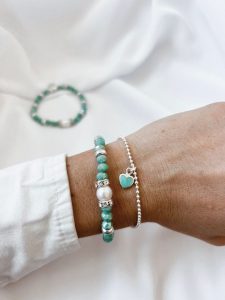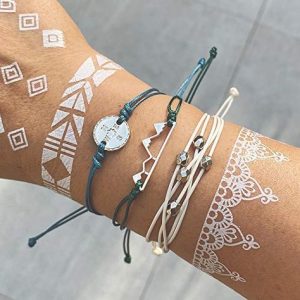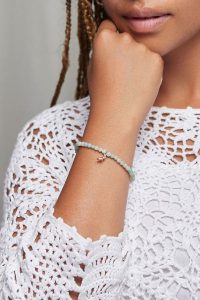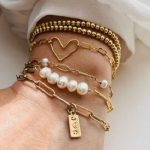Waterproof bracelets are a popular choice for active individuals who want to express their style without worrying about damaging their jewelry. They come in a wide variety of materials, each with its own unique advantages. This guide will explore the most common types of waterproof bracelets, helping you choose the perfect one for your needs.
Stainless Steel: A Timeless Choice
Stainless steel is a popular choice for bracelets due to its durability and versatility. Here’s what you need to know:
-
Strength and Shine: Stainless steel is resistant to rust, tarnishing, and corrosion, making it perfect for wear in water or during exercise. It maintains its shine over time.
-
Hypoallergenic: Stainless steel is a hypoallergenic material, ideal for people with sensitive skin.
-
Design Options: Stainless steel bracelets come in a wide range of styles, from sleek and minimalist to colorful and patterned. You can also find them with engravings or charms for a personalized touch.
While not the most lightweight option, stainless steel bracelets offer a great combination of durability and style.
Silicone: Comfort and Color
Silicone is another popular choice for waterproof bracelets, offering a comfortable and colorful option. Here’s a closer look:
-
Soft and Flexible: Silicone is a soft and flexible material that is comfortable to wear all day long.
-
Water Friendly: Silicone is completely waterproof and dries quickly, making it ideal for swimming, showering, or exercising.
-
Vast Colors: Silicone bracelets come in a vast array of colors, allowing you to match your style or show support for a cause. You can even find silicone bracelets with custom designs or motivational messages.
Silicone bracelets are a great choice for everyday wear or active lifestyles.
Paracord: Strength and Style
Paracord bracelets, also known as survival bracelets, are not only stylish but also functional. Here’s why they stand out:
-
Inner Strength: Paracord bracelets are woven from paracord, a lightweight yet strong nylon cord originally used for parachutes. In an emergency, the cord can be unraveled for various uses.
-
Water Resistant: Paracord is water resistant and dries quickly, making it suitable for most water activities.
-
Customizable Creativity: Paracord bracelets come in a vast array of colors and weaving patterns, allowing for endless customization. You can find tutorials online for creating unique and colorful designs.
While not fully waterproof, paracord bracelets offer a stylish and functional option for many wearers.
Leather: Classic and Sophisticated
Leather bracelets can also be waterproof, offering a touch of timeless elegance. Here’s what to consider:
-
Rich Look and Feel: Leather offers a classic and sophisticated look that complements many styles.
-
Water Resistance (with treatment): Natural leather is not inherently waterproof. However, some leather bracelets are treated with water-resistant finishes, making them suitable for light water exposure. Avoid submerging them for long periods.
-
Care Instructions: Leather bracelets with water-resistant treatments may require occasional care with leather protectants to maintain their appearance and water resistance.
Leather bracelets can be a stylish choice for those who want a more classic look, but be mindful of the water resistance limitations.

Choosing the Right Waterproof Bracelet for You
With so many options available, choosing the right waterproof bracelet depends on your needs and preferences. Here are some questions to consider:
-
What is your lifestyle? Do you need a bracelet for everyday wear, workouts, or occasional water activities?
-
What style are you going for? Do you prefer a classic, minimalist look, or something more colorful and eye-catching?
-
What is your budget? Waterproof bracelets come in a range of prices to suit your needs.
No matter your style or needs, there’s a perfect waterproof bracelet waiting to be discovered!

Beyond the Basics: Exploring Other Waterproof Materials
While stainless steel, silicone, paracord, and leather are some of the most common types of waterproof bracelets, there are other interesting options to consider:
- Eco-Conscious Choices: Companies are creating eco-friendly waterproof bracelets from recycled materials or bio-based plastics derived from plants. These are a great choice for those who want a sustainable option.
-
Bio-Based Materials: Some companies are creating eco-friendly waterproof bracelets using recycled materials or bio-based plastics derived from plants. These can be a great choice for those who want a sustainable option.
-
Fabric Bracelets: Certain types of fabric bracelets can be water resistant, especially those made with water-repellent materials or coated with a protective sealant. These might not be suitable for submersion but could handle splashes or light rain.
-
Bead Bracelets: Some waterproof bracelets incorporate beads made from waterproof materials like silicone or waxed rubber. These can offer a more colorful and decorative option.
Remember, when choosing a waterproof bracelet, consider the activities you’ll be doing while wearing it. If you’ll be swimming or submerging your wrist frequently, opt for a material like silicone or stainless steel. For everyday wear or light water exposure, you might explore other options.
Here are some additional tips for finding the perfect waterproof bracelet:
- Think about your style. Do you prefer something classic or colorful? Bold or minimalist?
- Consider your budget. Waterproof bracelets come in a range of prices.
- Read reviews. See what other people have to say about different brands and materials.
With so many options to choose from, you’re sure to find a waterproof bracelet that you’ll love!
Caring for Your Waterproof Bracelet
No matter the material, here are some general tips to keep your waterproof bracelet looking its best:
- Rinse with clean water after exposure to salt water or chlorine.
- Dry your bracelet completely before storing it.
- Avoid exposing your bracelet to harsh chemicals or excessive heat.
- Clean your bracelet gently with a mild soap and water solution if needed.
By following these tips, you can extend the life of your waterproof bracelet and enjoy it for years to come!
Conclusion
Waterproof bracelets are a versatile and stylish accessory for those who want to express themselves without worrying about damage from water or sweat. With a variety of materials, colors, and styles to choose from, there’s a perfect bracelet out there for everyone. So, explore your options, find a bracelet that reflects your style, and get ready to add a touch of waterproof flair to your wrist!





